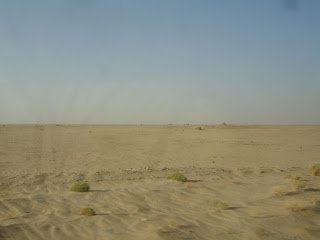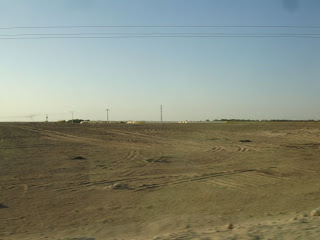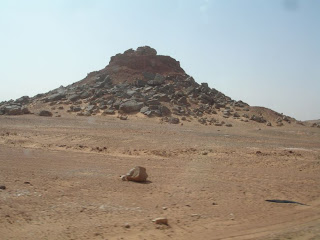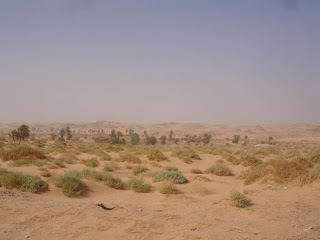October 12, 2008
September 20, 2008
Your tax dollars at work
I do not deny that something must be done to prevent the US, and consequently the world's, economy from going into a further tailspin. I won't even begrudge GWB for taking credit for 'fixing' a crisis entirely of his own making. I do however, have a question.
I'd like to know where all of the private jets, the mansions, the yachts, the wine collections, and the barrels of champagne are going to go. What's going to happen to the private islands and the racehorses? You know, those that were amassed by the deserving people who ran Bearn Stearns, AIG, etc...
Those people, we were told, were making absurd amounts of money because they were creating an absurd amount of wealth that all of us could enjoy. They were making credit available to all of us, and that kept the world economy humming. For this, they were paid billions (collectively, over the last 10 years, that is). It's called trickle down economics, to use a dated term.
Today, you, me, and your grandmother, are being asked to help bail these people out. So I repeat my question with a slight twist: can I get a timeshare on that private island? what about a few hours in that jet? I might even settle for a bottle of 1992 Dom Perignon, if there's any left.
June 27, 2008
A few more pictures
Sitting for tea and méchoui (whole wood-cooked lamb with herbs inside, eaten with hands)
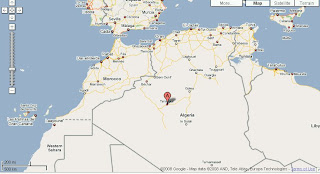
June 23, 2008
The foggaras
The basis of the system is that there is cliff in which there is a spring. At the bottom, you decide to plant palm trees. The spring is fed by a fossil aquifer that happens to surface at a given spot. As the water flows out of the spring, the level in the aquifer drops and the spring's flow rate ebbs.
To maintain the spring's flow, you can start digging a nearly horizontal gallery into the cliff, reaching back to the aquifer's front. The longer gallery you dig into the aquifer, the more flow your foggara generates. The beauty of the system is that the water flows by gravity (no pumping). Clearly, the aquifer's front will continue to recede away from the cliff as the foggara depletes the aquifer, and you'll be stuck digging further and further into the aquifer, always at a slight uphill.
Because this system is inherently low-tech, the galleries are unsupported and dangerous, which is why there are wells every 8-10 meters to ensure access all along the foggara. The longest foggara in Timimoun is 14km (9mi), and ends far into the desert. A foggara is therefore composed of two parts: one which is gaining water (in the aquifer itself), and one that is losing water (where the aquifer used to be).
From a socio-economic point of view, the foggaras are also very interesting, in that they are maintained in a cooperative manner. Clearly, the maintenance of 14km of tunnels is too much for a man and his sons. The water from that foggara is also more than is needed for the land a family can work.
The system works as follows: water flow is allocated on the basis of land ownership (lots of land=lots of water), and water and land rights are not separable. They can however be traded as a set. In proportion to his water rights, one is required to undertake repairs on the foggaras. Clearly, as parcels become more and more fragmented, it becomes increasingly difficult to coordinate the inputs of an ever-larger number of cooperative members, and the foggaras fall in disrepair. In addition, ever-smaller parcels become uneconomical and are abandoned by their owners, which leads to an increase in the marginal cost of repairs for each remaining individual land owner.
With all that said, we require a few illustrations... going along the flow.
Out in the desert, you can see the maintenance wells of the foggaras going on for miles.
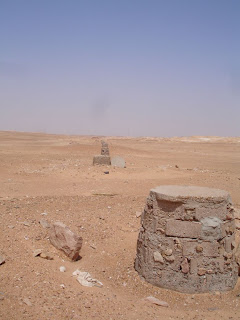
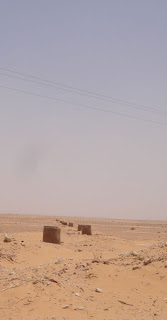
Once you reach town, the well covers can be more or less decorated (yes, that big white tower is a well cover).
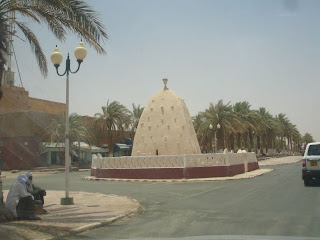
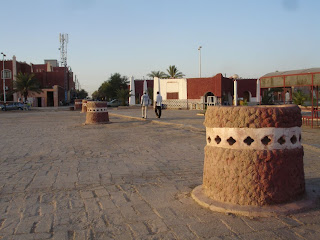
I was fortunate to go into one of these foggaras in two different parts. It was a bit like Indiana Jonesing through the Timimoun underworld...
Some parts are really narrow.
 As you can see, the bottom is unimproved, which explains why water will get 'lost' as it flows through this part of the gallery (currently no water is going because of repairs).
As you can see, the bottom is unimproved, which explains why water will get 'lost' as it flows through this part of the gallery (currently no water is going because of repairs).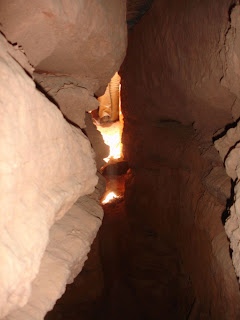
In another, functioning, foggara, near the outlet.
 Once the foggara reaches the hillside (cliff side), it emerges from it into what is called a 'comb' (un peigne). Water is then allocated by using the openings in the comb and channeled downhill to the parcels in question. The water can be further divided at downstream combs.
Once the foggara reaches the hillside (cliff side), it emerges from it into what is called a 'comb' (un peigne). Water is then allocated by using the openings in the comb and channeled downhill to the parcels in question. The water can be further divided at downstream combs.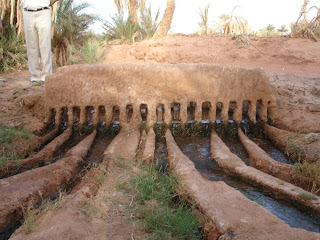
the same comb looking downhill. Notice the two combs. The first one serves to remove turbulence from the flow, thereby making the allocation by the second one fair.
 Open air channels take the water to the parcels. These are made of carved sandstone.
Open air channels take the water to the parcels. These are made of carved sandstone. Once the water reaches the individual properties, it's usually stored in a open air basin, such as this one.
Once the water reaches the individual properties, it's usually stored in a open air basin, such as this one.
Then the farmer will water individual 2x3 meter parcels separated by tiny dirt ridges, where he'll grow a variety of vegetables and legumes.
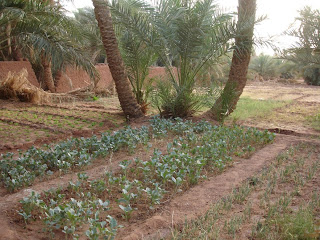
Some combs are broken (though this one might have been broken on purpose).
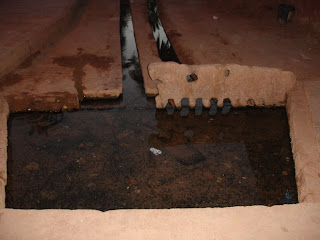
In the following two pictures, you can see the arrivals of various channels, and the complex allocation of water to various destinations. this results from the trading of land/water rights. It's actually quite intense if you care to zoom, with mini aqueducts. Wet clay indicates that these are maintained regularly.

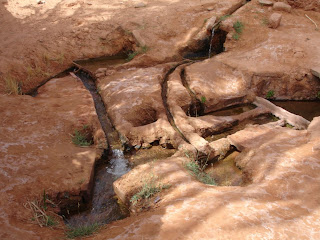
Below is a sub-comb, if you will, where the flow is further subdivided. the channel to the right side of the picture is freshly made.

Unfortunately, the longer the foggara, the longer the losing part, and the less efficient the foggara becomes. The amount of water it produces is a function of its length, as is and maintenance cost. The amount of arable land (and income) is constrained by the water available. It follows that the system is inherently flawed from an economic perspective. At some point, the cost of maintaining the foggara exceeds the profits to be made from working the land it waters. It appears that we've reached this point in Timimoun.
The Dunes
One morning, before sunrise, we asked a driver to take us there. The pictures do not do justice to the grandiose sight, and all it took to see this was to walk less than a mile in.
Here you can see the valley and Timimoun on the other side (ok, you can't really see Timimoun, but it's there).

Up close and personal with the dunes.
 Sunrise
Sunrise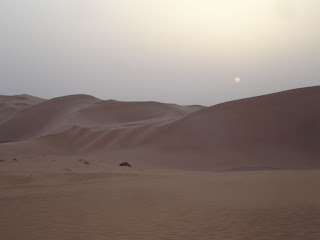 Something was here.
Something was here. You can see how big this place really is. In the background is the valley.
You can see how big this place really is. In the background is the valley. Some pictures without words.
Some pictures without words.
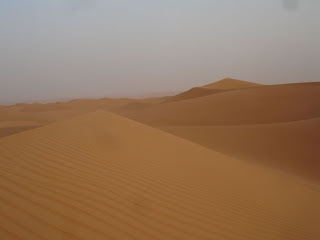
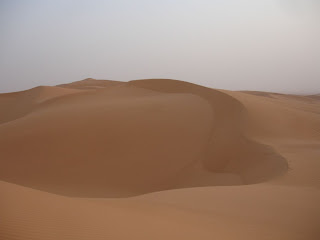

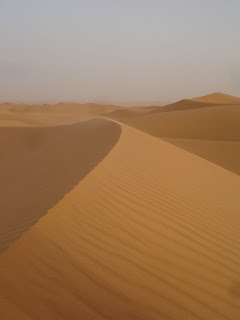
June 09, 2008
The Timimoun Ksar
The not-modern part (I wouldn't want to call it old, since I don't really know how old it is), is called the ksar, which means "fortified village" in Arabic, is the equivalent to the medina in Moroccan cities. I went for a stroll through the narrow sandy pathways as the day was falling, and took a few pictures. The ksar isn't very big, probably not more than 1-2 square kilometers, if that, but habitat is incredibly dense.
This is a public square in the middle of the ksar.
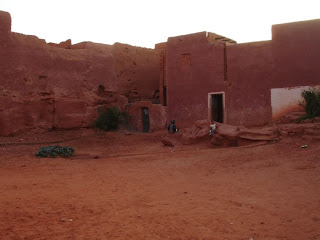 At the base of the castle, young boys play football on one of the few flat, paved surfaces of the area.
At the base of the castle, young boys play football on one of the few flat, paved surfaces of the area. Some streets are covered entirely (and the passages unlit). If you venture down this way, you'll find doors with numbers leading to private homes, but the passage is public space. Because the flat floors are supported by palm tree trunks (there is no other building material besides mud/straw bricks), the width of the streets is constrained at less than 2 meters. This is because the trunks do not have enough structural strength for longer spans. The guy is another expert on the mission.
Some streets are covered entirely (and the passages unlit). If you venture down this way, you'll find doors with numbers leading to private homes, but the passage is public space. Because the flat floors are supported by palm tree trunks (there is no other building material besides mud/straw bricks), the width of the streets is constrained at less than 2 meters. This is because the trunks do not have enough structural strength for longer spans. The guy is another expert on the mission. Sometimes, wider passages are built with archways, but those are rare. Zoom in on the picture and check out the bat flying by the expert's head.
Sometimes, wider passages are built with archways, but those are rare. Zoom in on the picture and check out the bat flying by the expert's head. On some walls, the cover is these hand-shaped mud balls.
On some walls, the cover is these hand-shaped mud balls. A wall and door in the ksar.
A wall and door in the ksar.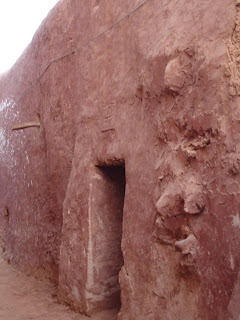 A tower for the castle
A tower for the castle A staircase leading to a private home.
A staircase leading to a private home. Another public space. Note the way that the infrastructure has worked around a large rock outcrop.
Another public space. Note the way that the infrastructure has worked around a large rock outcrop.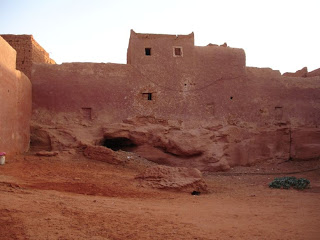
June 08, 2008
Adrar to Timimoun
So, the vast empty desert has stretches of vast empty emptiness, but it has other things as well. Some of which are portrayed below. Most taken from the car, which explains while they are not very good. In truth, the scenery along the road is not exceptionally beautiful, and I haven’t managed to take a good picture of Timimoun, where the view from the hotel and over the salt flats is absolutely staggering.
The vast empty emptiness. This is mostly the view from Adrar to Timimoun, until you get close to Timimoun.
Greenhouses just north of Adrar. Adrar prefecture is well-known for its produce (that’s right), which is grown using fossil water from below the Sahara. The amounts involved are very small compared to the overall volume of the aquifers, but the real problem is how to ship tomatoes 1800km north to Algiers.
Palm trees behind a mud-brick wall.
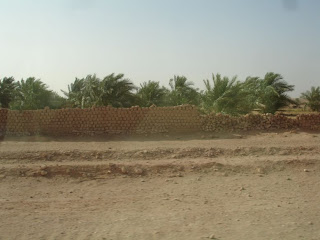 Sand flying over the road
Sand flying over the road
On getting close to Timimoun, the scenery changes and becomes a lot more interesting, with sand dunes, rock formations, etc…
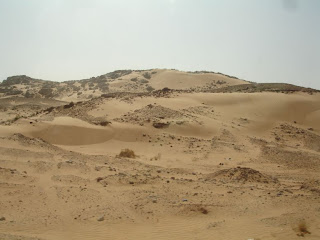
Palm trees, dunes, and grass
Arrival in Timimoun
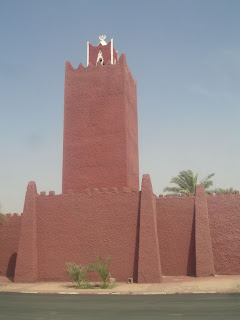
A poor attempt at capturing a grandiose view. I’m told the view’s even better in the winter, when the sky is much more blue.



